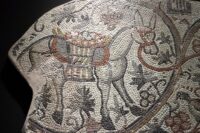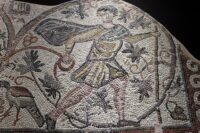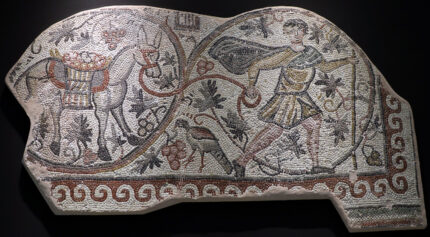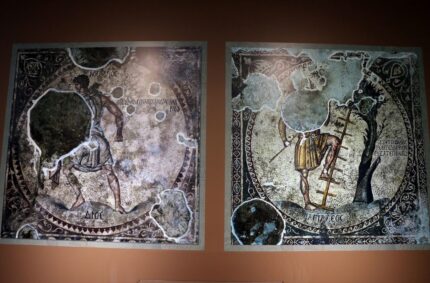A mosaic from late antiquity depicting a donkey carrying a basket full of grapes while a vineyard worker leads him by the bridle will be going on display in Antakya, Turkey, for the first time nearly 20 years after it was excavated.
The mosaic was first discovered in 2002 after looting activity in the Mazmanlı Quarter of Hassa district, 50 miles northeast of Antakya. A rescue excavation revealed the full 64 square feet of the mosaic which had originally adorned the floor of a church dating to the 5th or 6th century. It was moved to the Hatay Archeology Museum‘s warehouse in 2016. Since this summer, a team of six conservators have been working to remove the protective plaster it was encased with when it was lifted, reattaching loose tesserae and stitching the entire mosaic together from the sections it was divided into during the recovery process.
 The mosaic’s iconography attests to the importance of viticulture in the Amik Valley in the Late Roman Period, but the history of grape and wine production in what is now the Hatay Province of Turkey goes back even further than that and continues through to this day. The museum hoped to have the mosaic on display to bring in the Grape Harvest Festival on September 6th, but restoration took a full a six months.
The mosaic’s iconography attests to the importance of viticulture in the Amik Valley in the Late Roman Period, but the history of grape and wine production in what is now the Hatay Province of Turkey goes back even further than that and continues through to this day. The museum hoped to have the mosaic on display to bring in the Grape Harvest Festival on September 6th, but restoration took a full a six months.
 Fashionably late, the mosaic is now scheduled to make its dramatic debut next month in the temporary exhibition hall of the Hatay Archeology Museum. The Mosaic of the Vine Harvest will go on display with the replica of a Late Roman Period mosaic depicting the harvest of the other agricultural product of the area with just as ancient a tradition of cultivation: olives.
Fashionably late, the mosaic is now scheduled to make its dramatic debut next month in the temporary exhibition hall of the Hatay Archeology Museum. The Mosaic of the Vine Harvest will go on display with the replica of a Late Roman Period mosaic depicting the harvest of the other agricultural product of the area with just as ancient a tradition of cultivation: olives.
“Our mosaic comes to the fore every year during the grape harvest in our Hassa. Based on this, we wanted to introduce it to the visitors. As part of our project ‘The Traces of Olives and Grapes Engraved in History Come to Light,’ the importance of olives in the Hatay region and their spread to Anatolia and Europe as well as the importance of grapes for our province will be explained in our temporary exhibition hall,” [museum director Ayşe] Ersoy added.


A grape would have been referred to as σταφυλή (staphula), βότρυς (bótrus) or ῥάξ (rháx).
However, the olive part should be in much more detail! 😮 –I mean, who is supposed to ever read that Greek?– Under the feet of the dude on the right, it says “apilleos”, presumably from ἀπίλλω (apillo = “exclude”, maybe “harvest”?).
An olive would have been referred to as ἐλαίᾱ (elaíā). Next to the head of the dude to the left, it reads “No(v)embrios”, from Νοέμβρης (November), and seemingly the month is referred to. Presumably, the whole set is about the different activities during the agrarian year. Maybe, there are any other months.
Those “other” Greek ‘monsterwords’ are difficult to read. On the right, I presume, it talks of Thebes, (m)ἐπωλένιος (i.e. “upon the arm” –or in this case branch– as if the tree would talk), combined to a very long verb.
The fine print on the left seems to be “??oulomonareosandrasiphaino”:
μονάριος is the keeper of something, “andra” would be men, “(dra?)sifaino” seems to be a verb of (to me) unknown meaning, and certainly the first bit is some form of dialect :yes:
Is the second group of cyclical mosaics, especially the left one -Νοέμβριος- from the same excavation?
Alternatively, δρᾶσις (drasis) would be “strength, efficacy”, and φαίνω (phaino) “cause to appear, bring to light, show, uncover, reveal”. –Can I give a real expert a call? :confused: